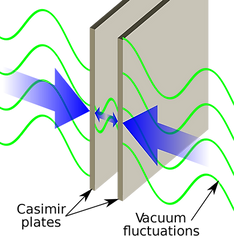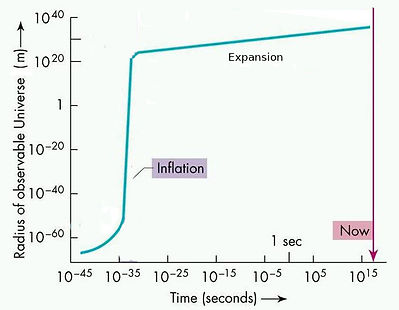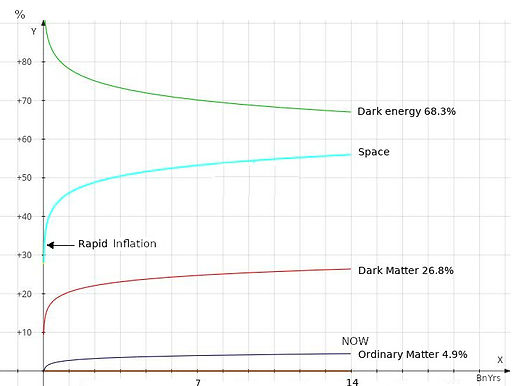

Birth of Our Universe
The likely beginnings of our universe
Our Universe Began from a Singularity in the Quantum Multiverse
The theory is that there was a Singularity formed which contained the Quantum Energy (Dark Energy) required for quantum fluctuations (see below) to build the space and matter of our universe. When time was applied the quantum fluctuations very rapidly began to construct space and matter (as proposed by physicist Alan Guth) causing the initial sudden inflation (which from our viewpoint would appear as a 'big bang'). Contrary to most people's undertanding, the created 'space' is not a vacuum of nothingness but has now been shown to be a structure of virtual particles containing energy. https://phys.org/news/2020-08-vacuum-fluctuations-space.html and https://phys.org/news/2019-04-fluctuations-void.html
This was confirmed by the Dutch physicist Hendrik Casimir who showed that that two metal plates placed in what we thought was a 'vacuum' are attracted to each other. It would seem that this cannot be if there is 'nothing' in the 'vacuum' but according to quantum theory, particles constantly appear and disappear there as a result of their interaction with the plates and this is due to quantum vacuum fluctuations (which would need energy, perhaps dark energy to do this). Casimir realised that between two plates, only those virtual photons whose wavelengths fit a whole number of times into the gap should be counted when calculating the vacuum energy. The energy density decreases as the macroscopic gap between plates are moved closer together, which implies that there is a small force drawing them together. The effect is due to the modification of the zero point energy of QED (Quantum ElectroDynamics) when two perfectly conducting plates are put very close to each other.

This sudden inflation would generate a lot of heat-like radiation, resulting in the Cosmic Microwave Background we see now. My theory cannot agree on a very dense universe before the sudden inflation because neither matter nor space had been created then. The sudden inflation could have been caused by applying an enormous amount of energy for quantum fluctuations to create 'space' and 'time' to provide the foundations of the Universe. I suggest that this energy is the dark energy that we are now aware of.
The confirmation of Quantum Fluctuations as the building mechanisms of space and time foundations has provided more subtle reasons for what we perceive as a big bang, as explained later. Although the Cosmic Microwave Background (CMB) began during the Inflation period, it wasn't released, due to the scattering effect of atomic particles, until the time of 'recombination', 380,000 years after the rapid inflation, when photons started to propagate freely across the Universe because hydrogen atoms started to form then, allowing the CMB to pass through without being scattered, eventually reaching the detectors in the instruments on board the Planck space craft. Physicist Alan Guth theorized that the universe inflated extremely rapidly and became exponentially larger in a fraction of a second (10^-32 second). However, there might be problems measuring time during that inflation, especially if you accept that neither space nor time had been completely formed until the end of inflation.
Dark Energy does also seem to have an influence on the construction of space and matter after the foundations were laid because the value last measured was lower than a previous one but matter and space had increased. Therefore, it wouldn't be unreasonable to assume that Dark Energy is the energy required by Quantum Fluctuations to construct our Universe. This would also suggest that the initial state was not an unimaginably hot, dense singularity because temperature would not have any meaning then. This is because matter didn`t exist then and heat is either measured by radiation or vibration of molecules (neither of which existed then)?

The formation of particles may not have required heat (as we know it) to form. Initially, during the inflation phase, time was probably still being formed which would look to us like a fraction of a second but the actions performed were outside our familiar understanding of time and 'space' or we simply do not understand the physics of this period. The process of forming 'space' during that process would also determine the eventual gravitational effects, hence gravitational waves during that process may not have been completed until it finished. See CMB Polarization and Inflation.
It seems logical that the initial Quantum Energy is the Dark Energy shown in the graph below and the Quantum Fluctuations use this energy to make 'space' and matter. Thus the Dark Energy starts at 100% then it suddenly decreases (aka the big bang) then is slowly depleted until NOW at 68.3%. Quantum Fluctuations make Ordinary Matter and Dark Matter from Dark Energy. Dark Matter has a gravitational effect on Ordinary Matter but is not visible. Perhaps when Dark Matter was formed, its time was out of phase with Ordinary Matter, hence not visible.
Everything is formed by Quantum Fluctuations
Physicists (2016) have now confirmed that apparently matter is actually no more than fluctuations in the quantum vacuum https://www.newscientist.com/article/dn16095-its-confirmed-matter-is-merely-vacuum-fluctuations/. The researchers simulated the frantic activity that goes on inside protons and neutrons. These particles provide almost all the mass of ordinary matter. Each proton (or neutron) is made of three or more quarks (depending on energy levels) – but the individual masses of these quarks only add up to about 1% of the proton’s mass. So what accounts for the rest of it? Theory says it is created by the force that binds quarks together, called the strong nuclear force. In quantum terms, the strong force is carried by a field of virtual particles called gluons, randomly popping into existence and disappearing again. The binding tube of force (gluons) holding the Quarks remains constant regardless of distance but energy (hence mass) is required to build that tube. The energy/mass relationship (E=mC^2) of these vacuum fluctuations has to be included in the total mass of the proton and neutron. I think that these gluon vacuum fluctuations provide the conduit for dark energy to build and bind the particles.
It must be the same quantum fluctuations that form matter as well as the vacuum energy of 'space'. In fact, I think that these fluctuations are like the primal fluctuation 'programs' (like DNA) that have been passed on from the Quantum Multiverse. The Quantum Multiverse just passes on a package of energy with instructions which initiates and builds a universe like ours. These instructions may be the result of universe building evolutionary processes.

According to the Planck cosmology probe results, the all-sky map of the cosmic microwave background CMB, our universe was 13.798±0.037billion years old, and contains 4.9% ordinary matter, 26.8% dark matter and 68.3% dark energy as shown in the graph above (time = NOW). Also, the Hubble constant was measured to be 67.80 ± 0.77 (km/s)/Mpc. The results also revise downwards (from WMAP probe measurements) the proportion of the universe made up by dark energy from 71% to 68.3%, while dark matter accounts for 26.8% of the total (up from 24%) and ordinary matter 4.9% (up from 4.6%). This fits well with my theory that dark energy is the source energy producing dark and ordinary matter. The graph above shows an interpretation of how these values have changed over the life of our universe so far with dark energy slowly being used to produce 'space' and 'matter'. It follows that, if quantum fluctuations build 'space', then dark energy probably is the energy of the vacuum of space, which is why it could be an enormous source of energy if it could be extracted.
As discussed earlier in this section, the absolute nothingness of the vacuum of 'space' has no reality, as proven by Casimir's experiment. Quite to the contrary, quantum field theory has shown that 'seemingly empty space' is filled by fluctuations of light and matter fields, leading to a continuous popping into existence and disappearance of photons as well as massive particles. The 'seemingly empty space' is simply our limited interpretation of 'space' because we do not have the senses to detect these quantum fluctuations in the same way that we relate to the air around us. Now we can detect the effect of quantum fluctuations in the same way that we can measure air pressure, although we can sense the movement of air. These quantum fluctuations have been physically measured recently on the New LIGO gravity field detector: https://news.mit.edu/2020/quantum-fluctuations-jiggle-objects-0701
Albert Einstein published his Special Theory of Relativity in 1905 and in doing so demonstrated that mass and energy are actually the same thing, with one a tightly compressed manifestation of the other. This resulted in his famous equation E=mC^2, relating energy to mass. However, to relate this to the energy, matter and 'space' in our universe, it is necessary to expand his theory to show the relationship between the four elements below which shows :
Ed = Edb-[MoC^2+MdC^2+Ev]
Where Ed is dark energy now, Edb is dark energy at the beginning of our universe, Mo is ordinary matter, Md is dark matter, Ev is vacuum energy (space) and C is the speed of light.
An enormous amount of dark energy must have been used during the inflation period. So, if 68.3% of dark energy remains from the BB until now, the amount used during Inflation plus Expansion until NOW would be 100-68.3 = 31.7%. According to inflation theory, during the inflationary epoch about 10^−32 of a second after the Big Bang, the universe suddenly expanded, and its volume increased by a factor of at least 10^78 [Wikipedia]. By estimating the ratio of volume of Inflation with Expansion to determine the remaining dark energy available for Expansion, I arrived at a figure of 676 bn years (see Character of Universe for calculation) when dark energy will be depleted, i.e. the end of our Universe (assuming a linear expansion).


